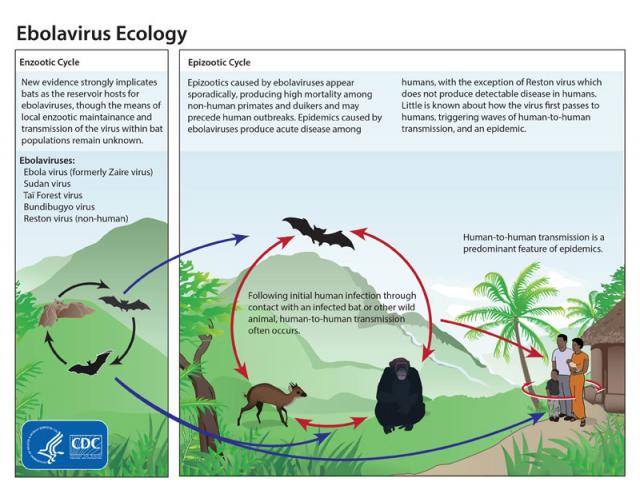Ebola hemorrhagic fever (Ebola HF) is one of numerous Viral Hemorrhagic Fevers. It is a severe, often fatal disease in humans and nonhuman primates (such as monkeys, gorillas, and chimpanzees).
Ebola HF is caused by infection with a virus of the genus Ebolavirus. When infection occurs, symptoms usually begin abruptly. The first Ebolavirus species was discovered in 1976 in what is now the Democratic Republic of the Congo near the Ebola River. Since then, outbreaks have appeared sporadically.
There are five identified subspecies of Ebolavirus. Four of the five have caused disease in humans: Ebola virus (Zaire ebolavirus); Sudan virus (Sudan ebolavirus); Taï Forest virus (Taï Forest ebolavirus, formerly Côte d’Ivoire ebolavirus); and Bundibugyo virus (Bundibugyo ebolavirus). The fifth, Reston virus (Reston ebolavirus), has caused disease in nonhuman primates, but not in humans.
The natural reservoir host of ebolaviruses remains unknown. However, on the basis of available evidence and the nature of similar viruses, researchers believe that the virus is zoonotic (animal-borne) with bats being the most likely reservoir. Four of the five subtypes occur in an animal host native to Africa.
A host of similar species is probably associated with Reston virus, which was isolated from infected cynomolgous monkeys imported to the United States and Italy from the Philippines. Several workers in the Philippines and in US holding facility outbreaks became infected with the virus, but did not become ill.
Because the natural reservoir of ebolaviruses has not yet been proven, the manner in which the virus first appears in a human at the start of an outbreak is unknown. However, researchers have hypothesized that the first patient becomes infected through contact with an infected animal.
When an infection does occur in humans, there are several ways in which the virus can be transmitted to others. These include:
- direct contact with the blood or secretions of an infected person
- exposure to objects (such as needles) that have been contaminated with infected secretions
The viruses that cause Ebola HF are often spread through families and friends because they come in close contact with infectious secretions when caring for ill persons.
During outbreaks of Ebola HF, the disease can spread quickly within health care settings (such as a clinic or hospital). Exposure to ebolaviruses can occur in health care settings where hospital staff are not wearing appropriate protective equipment, such as masks, gowns, and gloves.
Proper cleaning and disposal of instruments, such as needles and syringes, is also important. If instruments are not disposable, they must be sterilized before being used again. Without adequate sterilization of the instruments, virus transmission can continue and amplify an outbreak.
Symptoms of Ebola HF typically include:
- Fever
- Headache
- Joint and muscle aches
- Weakness
- Diarrhea
- Vomiting
- Stomach pain
- Lack of appetite
Some patients may experience:
- A Rash
- Red Eyes
- Hiccups
- Cough
- Sore throat
- Chest pain
- Difficulty breathing
- Difficulty swallowing
- Bleeding inside and outside of the body
Symptoms may appear anywhere from 2 to 21 days after exposure to ebolavirus though 8-10 days is most common.
Some who become sick with Ebola HF are able to recover, while others do not. The reasons behind this are not yet fully understood. However, it is known that patients who die usually have not developed a significant immune response to the virus at the time of death.
Diagnosing Ebola HF in an individual who has been infected for only a few days is difficult, because the early symptoms, such as red eyes and a skin rash, are nonspecific to ebolavirus infection and are seen often in patients with more commonly occurring diseases.
However, if a person has the early symptoms of Ebola HF and there is reason to believe that Ebola HF should be considered, the patient should be isolated and public health professionals notified. Samples from the patient can then be collected and tested to confirm infection.
Laboratory tests used in diagnosis include:
After symptoms arise:
- Antigen-capture enzyme-linked immunosorbent assay (ELISA) testing
- IgM ELISA
- Polymerase chain reaction (PCR)
- Virus isolation
Later in disease course or after recovery:
- IgM and IgG antibodies
Retrospectively:
- Immunohistochemistry testing
- PCR
- Virus isolation
Standard treatment for Ebola HF is still limited to supportive therapy. This consists of:
- balancing the patient’s fluids and electrolytes
- maintaining their oxygen status and blood pressure
- treating them for any complicating infections
Timely treatment of Ebola HF is important but challenging since the disease is difficult to diagnose clinically in the early stages of infection. Because early symptoms such as headache and fever are nonspecific to ebolaviruses, cases of Ebola HF may be initially misdiagnosed.
However, if a person has the early symptoms of Ebola HF and there is reason to believe that Ebola HF should be considered, the patient should be isolated and public health professionals notified. Supportive therapy can continue with proper protective clothing until samples from the patient are tested to confirm infection.
Experimental treatments have been tested and proven effective in animal models but has not yet been used in humans.
http://www.cdc.gov/vhf/ebola/index.html
http://www.cdc.gov/vhf/ebola/resources/virus-ecology.html
